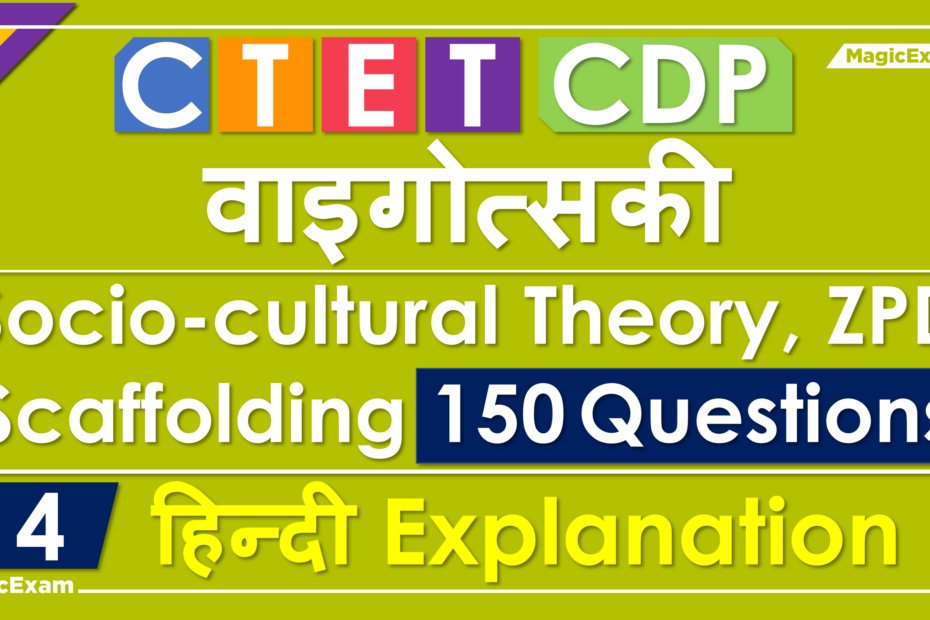Subscribe to MagicExam YouTube channel for free videos on CTET 2025 and 2026, KVS, TET, REET, DSSSB, UPTET, MPTET, MahaTET, APTET, TSTET, RTET, HTET, PSTET, KARTET, TNTET and other Teaching exam preparation, solved question papers, syllabus analysis, result related news and other information videos.
If you have any questions, comments or feedback - please post them as YouTube comments under the specific videos and we will clarify or reply as soon as possible.
Answer for the Question : 00:00 – Intro
Answer for the Question : 01:24 – Child : I am not able to fix this part of the puzzle. Teacher : Which piece should come here as these are the legs of the cat ? Child : The paws ? Teacher : Good! Which piece like a paw ? Child : This one. Which feature of social interaction is being highlighted in the above interaction ? – Observational learning – Expository learning – Scaffolding – Cognitive conflict
Answer for the Question : 01:59 – Children construct new knowledge on the basis of – what is already understood and believed by them – what is ambiguous and irrelevant for them – what is completely alien and foreign to them – what is extremely beyond their current cognitive level
Answer for the Question : 04:08 – Children learn by : (i) Reading (ii) Listening (iii) Seeing (iv) Doing Choose the correct option – (i) (ii) – (i) (ii) (iii) – (ii) (iii) (iv) – (i) (ii) (iii) (iv)
Answer for the Question : 04:44 – Children of 4-5 years often talk to themselves. This talk according to Lev Vygotsky – Reflects their egocentrism – Hinders their cognitive development – Hinders their social development – Helps them to regulate their own thinking
Answer for the Question : 05:41 – Children’s engagement with learning in schools is influenced by which of the following factors ? (i) Socialisation by the family (ii) Peer relations (iii) Cultural values (iv) Self-esteem of the children – (iv) – (ii) and (iv) – (i), (ii), (iii), (iv) – (i), (iii)
Answer for the Question : 06:46 – Classroom environment has a significant on children’s learning. To inculcate a culture of mastery-oriented learning (learning that focuses on understanding), learning, classroom environment should be – Performance oriented – competitive and individualistic – teacher dominated – cooperative and collaborative
Answer for the Question : 07:42 – Conceptual changes in children’s thinking should be encouraged by – the use of punishment – giving multiple examples and encouraging children to reason – asking children to memorize the ‘correct concepts’ – repeated drill and practice
Answer for the Question : 09:29 – Constructivist view of learning suggests that children ______ construction of their own knowledge – have no role to play in – are solely dependent on adults for – play an active role in – are solely dependent on textbooks in
Answer for the Question : 10:54 – Constructivists such as Jean Piaget and Lev Vygotsky learning as ? – acquisition of skills – conditioning of responses – passive repetitive process – process of meaning-making by active engagement
Answer for the Question : 12:38 – Development is dependent upon (i) Genetic makeup (ii) Physical Environment (iii) Socio-cultural factors Choose the correct option – (i), (ii) – (ii), (iii) – (i), (iii) – (i), (ii), (iii)
Answer for the Question : 13:34 – Discussions in groups and positive teacher-student relationships characterize a – progressive classroom – textbook-centric classroom – behaviouristic classroom – teacher-centric classroom
Answer for the Question : 15:11 – During a task, Saina is talking to herself about ways she can proceed on the task. According to Lev Vygotsky’s ideas on language and thought; this kind of ‘private speech’ is a sign of – Cognitive immaturity – Self-regulation – Ego-centricism – Psychological disorder
Answer for the Question : 15:50 – Flexible seating arrangement, learners working in groups, are characteristics of a – Behaviouristic classroom – Socio-constructivist classroom – Teacher centric classroom – Textbook centric classroom
Answer for the Question : 16:58 – Giving cues to children and offering support as and when needed is an example of ? – reinforcement – conditioning – modelling – scaffolding
Answer for the Question : 17:34 – Giving students the opportunity to discuss their experiences of celebration of festivals in the classroom and building upon that information is an example of using – Behaviourism – Direct Instruction – Social constructivism – Textbook centred teaching
Click on the YouTube video link in the article above, to watch the entire video on YouTube. You can also click on the 'Chapter' link time-stamps to go directly to the specific question or part of the video.
Subscribe to MagicExam YouTube channel for free videos on CTET 2025 and 2026, KVS, TET, REET, DSSSB, UPTET, MPTET, MahaTET, APTET, TSTET, RTET, HTET, PSTET, KARTET, TNTET and other teaching exam preparation, solved question papers, syllabus analysis, result related news and other information videos.
If you have any questions, comments or feedback - please post them as YouTube comments under the specific videos and we will clarify or reply as soon as possible.
